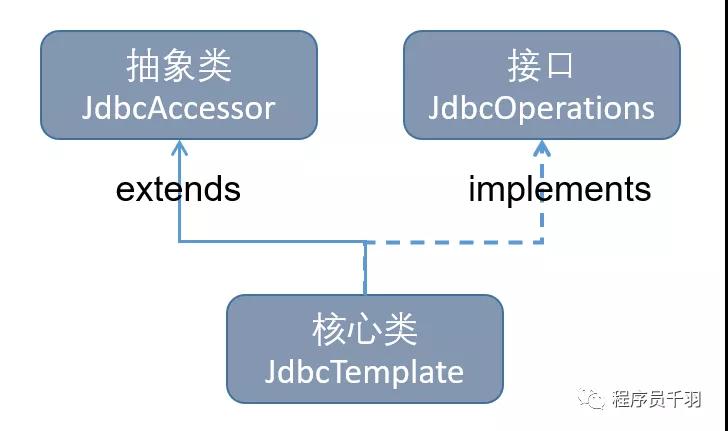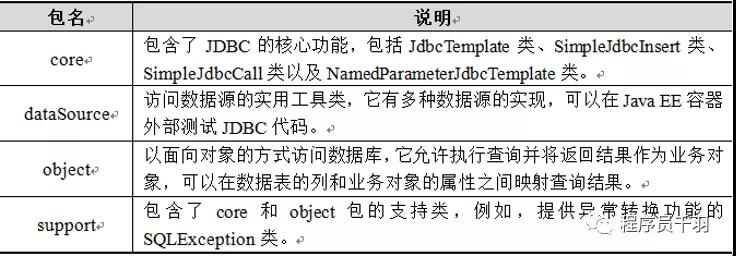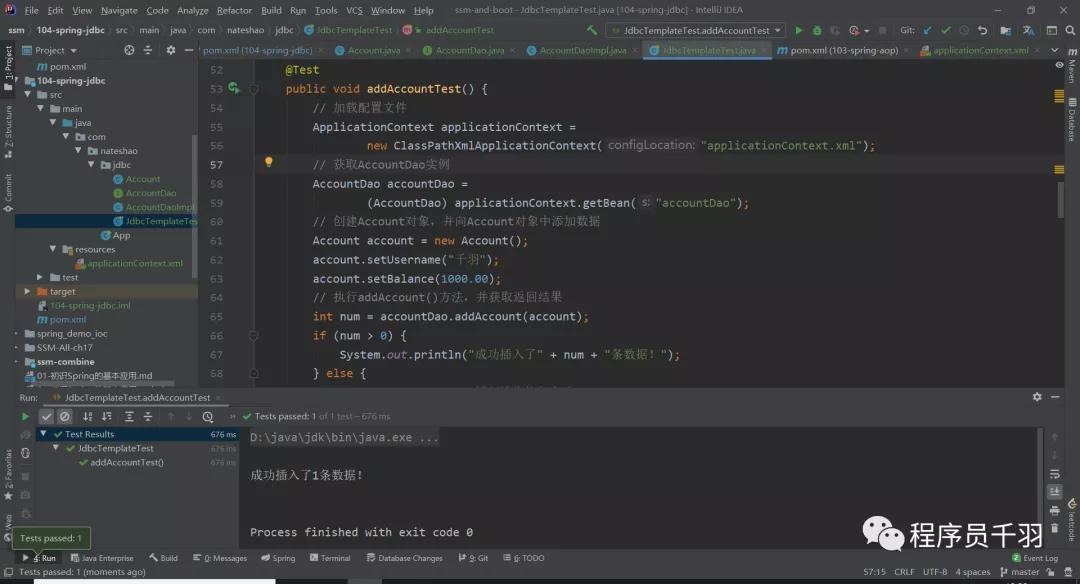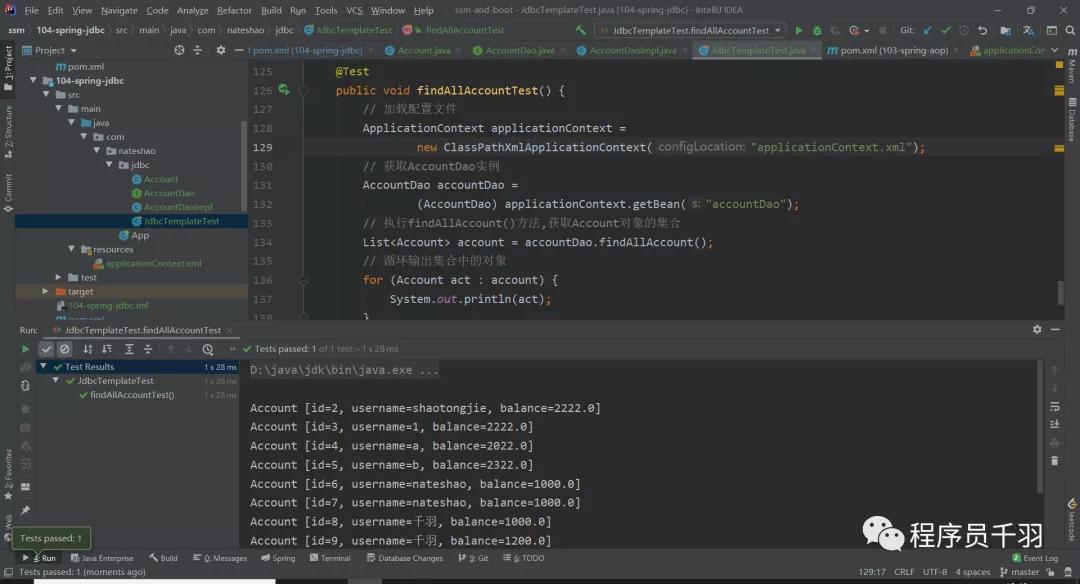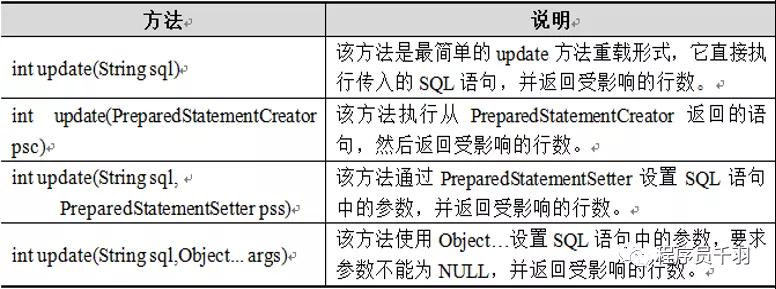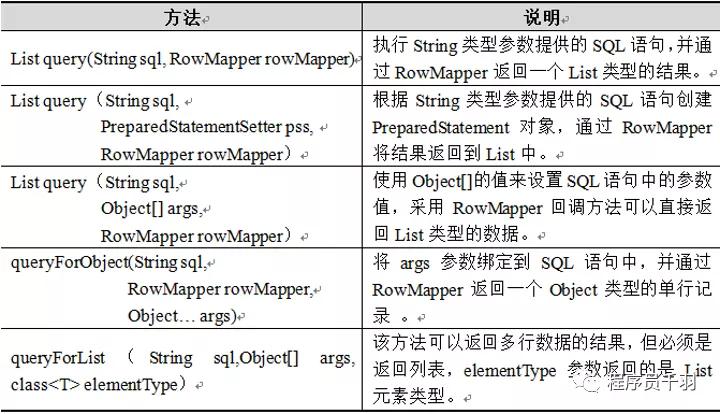- 1. Spring JDBC
- Spring JDBC的配置
- 2. Spring JdbcTemplate的常用方法
- execute()
- 总结
GitHub:https://github.com/nateshao/ssm/tree/master/104-spring-jdbc
1. Spring JDBC
Spring JDBC模块有什么作用?
Spring的JDBC模块负责数据库资源管理和错误处理,大大简化了开发人员对数据库的操作,使得开发人员可以从繁琐的数据库操作中解脱出来,从而将更多的精力投入到编写业务逻辑当中。
Spring JdbcTemplate的解析
针对数据库的操作,Spring框架提供了JdbcTemplate类,该类是Spring框架数据抽象层的基础。可以说,JdbcTemplate类是Spring JDBC的核心类。
JdbcTemplate类的继承结构具体如下图所示:
从JdbcTemplate的继承关系图可以看出,JdbcTemplate类的直接父类是JdbcAccessor,该类为子类提供了一些访问数据库时使用的公共属性。
DataSource:其主要功能是获取数据库连接,还可以引入对数据库连接的缓冲池和分布式事务的支持,它可以作为访问数据库资源的标准接口。
SQLExceptionTranslator:该接口负责对SQLException进行转译工作。通过必要的设置获取SQLExceptionTranslator中的方法,可以使JdbcTemplate在需要处理SQLException时,委托SQLExceptionTranslator的实现类来完成相关的转译工作。
而JdbcOperations接口定义了在JdbcTemplate类中可以使用的操作集合,包括添加、修改、查询和删除等操作。
Spring JDBC的配置
Spring JDBC模块主要由4个包组成,分别是core(核心包)、dataSource(数据源包)、object(对象包)和support(支持包)。
从上表可以看出,Spring对数据库的操作都封装在了这几个包中,而想要使用Spring JDBC,就需要对其进行配置。
<?xml version="1.0" encoding="UTF-8"?>
<beans xmlns="http://www.springframework.org/schema/beans"
xmlns:xsi="http://www.w3.org/2001/XMLSchema-instance"
xsi:schemaLocation="http://www.springframework.org/schema/beans
http://www.springframework.org/schema/beans/spring-beans-4.3.xsd">
<!-- 1配置数据源 -->
<bean id="dataSource" class=
"org.springframework.jdbc.datasource.DriverManagerDataSource">
<!--数据库驱动 -->
<property name="driverClassName" value="com.mysql.jdbc.Driver" />
<!--连接数据库的url -->
<property name="url" value="jdbc:mysql://localhost:3306/spring" />
<!--连接数据库的用户名 -->
<property name="username" value="root" />
<!--连接数据库的密码 -->
<property name="password" value="123456" />
</bean>
<!-- 2配置JDBC模板 -->
<bean id="jdbcTemplate"
class="org.springframework.jdbc.core.JdbcTemplate">
<!-- 默认必须使用数据源 -->
<property name="dataSource" ref="dataSource" />
</bean>
<!--定义id为accountDao的Bean-->
<bean id="accountDao" class="com.nateshao.jdbc.AccountDaoImpl">
<!-- 将jdbcTemplate注入到accountDao实例中 -->
<property name="jdbcTemplate" ref="jdbcTemplate" />
</bean>
</beans>
- 1.
- 2.
- 3.
- 4.
- 5.
- 6.
- 7.
- 8.
- 9.
- 10.
- 11.
- 12.
- 13.
- 14.
- 15.
- 16.
- 17.
- 18.
- 19.
- 20.
- 21.
- 22.
- 23.
- 24.
- 25.
- 26.
- 27.
- 28.
- 29.
- 30.
- 31.
关于上述示例dataSource配置中的4个属性说明,如下表所示:
注意:上表中的属性值在实际配置时,需要根据数据库类型和设置进行相应配置。
2. Spring JdbcTemplate的常用方法
“在JdbcTemplate核心类中,提供了大量的更新和查询数据库的方法,我们就是使用的这些方法来操作数据库的。
execute( ):execute(String sql)方法可用于执行sql语句update():update())用于执行插入、更新和删除操作query():query()用于执行数据查询操作
execute()
使用execute(String sql)方法执行建表的案例实现步骤如下:
- 在MySQL中创建一个名为spring的数据库;
- 创建Web项目,导入相关maven包;
- 创建Spring配置文件,配置数据源和JDBC模板;
- 创建测试类,
- 测试程序。
Spring.sql
CREATE DATABASE IF NOT EXISTS `spring` ;
USE `spring`;
/*Table structure for table `account` */
DROP TABLE IF EXISTS `account`;
CREATE TABLE `account` (
`id` int(11) NOT NULL AUTO_INCREMENT,
`username` varchar(50) DEFAULT NULL,
`balance` double DEFAULT NULL,
PRIMARY KEY (`id`)
) ENGINE=InnoDB AUTO_INCREMENT=6 DEFAULT CHARSET=utf8;
/*Data for the table `account` */
insert into `account`(`id`,`username`,`balance`) values (2,'shaotongjie',2222),(3,'1',2222),(4,'a',2022),(5,'b',2322);
- 1.
- 2.
- 3.
- 4.
- 5.
- 6.
- 7.
- 8.
- 9.
- 10.
- 11.
- 12.
- 13.
- 14.
- 15.
- 16.
- 17.
- 18.
Account.java
package com.nateshao.jdbc;
/**
* @date Created by 邵桐杰 on 2021/10/15 15:50
* @微信公众号 程序员千羽
* @个人网站 www.nateshao.cn
* @博客 https://nateshao.gitee.io
* @GitHub https://github.com/nateshao
* @Gitee https://gitee.com/nateshao
* Description:
*/
@Data
public class Account {
private Integer id; // 账户id
private String username; // 用户名
private Double balance; // 账户余额
}
- 1.
- 2.
- 3.
- 4.
- 5.
- 6.
- 7.
- 8.
- 9.
- 10.
- 11.
- 12.
- 13.
- 14.
- 15.
- 16.
- 17.
applicationContext.xml
<?xml version="1.0" encoding="UTF-8"?>
<beans xmlns="http://www.springframework.org/schema/beans"
xmlns:xsi="http://www.w3.org/2001/XMLSchema-instance"
xsi:schemaLocation="http://www.springframework.org/schema/beans
http://www.springframework.org/schema/beans/spring-beans-4.3.xsd">
<!-- 1配置数据源 -->
<bean id="dataSource" class=
"org.springframework.jdbc.datasource.DriverManagerDataSource">
<!--数据库驱动 -->
<property name="driverClassName" value="com.mysql.jdbc.Driver" />
<!--连接数据库的url -->
<property name="url" value="jdbc:mysql://localhost:3306/spring?useSSL=false" />
<!--连接数据库的用户名 -->
<property name="username" value="root" />
<!--连接数据库的密码 -->
<property name="password" value="123456" />
</bean>
<!-- 2配置JDBC模板 -->
<bean id="jdbcTemplate"
class="org.springframework.jdbc.core.JdbcTemplate">
<!-- 默认必须使用数据源 -->
<property name="dataSource" ref="dataSource" />
</bean>
<!--定义id为accountDao的Bean-->
<bean id="accountDao" class="com.nateshao.jdbc.AccountDaoImpl">
<!-- 将jdbcTemplate注入到accountDao实例中 -->
<property name="jdbcTemplate" ref="jdbcTemplate" />
</bean>
</beans>
- 1.
- 2.
- 3.
- 4.
- 5.
- 6.
- 7.
- 8.
- 9.
- 10.
- 11.
- 12.
- 13.
- 14.
- 15.
- 16.
- 17.
- 18.
- 19.
- 20.
- 21.
- 22.
- 23.
- 24.
- 25.
- 26.
- 27.
- 28.
- 29.
- 30.
- 31.
AccountDao.java
package com.nateshao.jdbc;
import java.util.List;
/**
* @date Created by 邵桐杰 on 2021/10/15 15:50
* @微信公众号 程序员千羽
* @个人网站 www.nateshao.cn
* @博客 https://nateshao.gitee.io
* @GitHub https://github.com/nateshao
* @Gitee https://gitee.com/nateshao
* Description:
*/
public interface AccountDao {
// 添加
public int addAccount(Account account);
// 更新
public int updateAccount(Account account);
// 删除
public int deleteAccount(int id);
// 通过id查询
public int queryAccountById(int id);
// 查询所有账户
public List<Account> findAllAccount();
Account findAccountById(int i);
}
- 1.
- 2.
- 3.
- 4.
- 5.
- 6.
- 7.
- 8.
- 9.
- 10.
- 11.
- 12.
- 13.
- 14.
- 15.
- 16.
- 17.
- 18.
- 19.
- 20.
- 21.
- 22.
- 23.
- 24.
- 25.
- 26.
- 27.
- 28.
- 29.
- 30.
AccountDaoImpl.java
package com.nateshao.jdbc;
import org.springframework.jdbc.core.BeanPropertyRowMapper;
import org.springframework.jdbc.core.JdbcTemplate;
import org.springframework.jdbc.core.RowMapper;
import java.util.List;
/**
* @date Created by 邵桐杰 on 2021/10/15 15:55
* @微信公众号 程序员千羽
* @个人网站 www.nateshao.cn
* @博客 https://nateshao.gitee.io
* @GitHub https://github.com/nateshao
* @Gitee https://gitee.com/nateshao
* Description:
*/
public class AccountDaoImpl implements AccountDao {
// 声明JdbcTemplate属性及其setter方法
private JdbcTemplate jdbcTemplate;
public void setJdbcTemplate(JdbcTemplate jdbcTemplate) {
this.jdbcTemplate = jdbcTemplate;
}
/**
* 添加账户
* @param account
* @return
*/
public int addAccount(Account account) {
// 定义SQL
String sql = "insert into account(username,balance) value(?,?)";
// 定义数组来存放SQL语句中的参数
Object[] obj = new Object[]{
account.getUsername(),
account.getBalance()
};
// 执行添加操作,返回的是受SQL语句影响的记录条数
int num = this.jdbcTemplate.update(sql, obj);
return num;
}
/**
* 更新账户
* @param account
* @return
*/
public int updateAccount(Account account) {
// 定义SQL
String sql = "update account set username=?,balance=? where id = ?";
// 定义数组来存放SQL语句中的参数
Object[] params = new Object[]{
account.getUsername(),
account.getBalance(),
account.getId()
};
// 执行添加操作,返回的是受SQL语句影响的记录条数
int num = this.jdbcTemplate.update(sql, params);
return num;
}
/**
* 删除账户
* @param id
* @return
*/
public int deleteAccount(int id) {
// 定义SQL
String sql = "delete from account where id = ? ";
// 执行添加操作,返回的是受SQL语句影响的记录条数
int num = this.jdbcTemplate.update(sql, id);
return num;
}
@Override
public int queryAccountById(int id) {
return 0;
}
/**
* 通过id查询账户数据信息
* @param id
* @return
*/
public Account findAccountById(int id) {
//定义SQL语句
String sql = "select * from account where id = ?";
// 创建一个新的BeanPropertyRowMapper对象
RowMapper<Account> rowMapper =
new BeanPropertyRowMapper<Account>(Account.class);
// 将id绑定到SQL语句中,并通过RowMapper返回一个Object类型的单行记录
return this.jdbcTemplate.queryForObject(sql, rowMapper, id);
}
/**
* 查询所有账户信息
* @return
*/
public List<Account> findAllAccount() {
// 定义SQL语句
String sql = "select * from account";
// 创建一个新的BeanPropertyRowMapper对象
RowMapper<Account> rowMapper =
new BeanPropertyRowMapper<Account>(Account.class);
// 执行静态的SQL查询,并通过RowMapper返回结果
return this.jdbcTemplate.query(sql, rowMapper);
}
}
- 1.
- 2.
- 3.
- 4.
- 5.
- 6.
- 7.
- 8.
- 9.
- 10.
- 11.
- 12.
- 13.
- 14.
- 15.
- 16.
- 17.
- 18.
- 19.
- 20.
- 21.
- 22.
- 23.
- 24.
- 25.
- 26.
- 27.
- 28.
- 29.
- 30.
- 31.
- 32.
- 33.
- 34.
- 35.
- 36.
- 37.
- 38.
- 39.
- 40.
- 41.
- 42.
- 43.
- 44.
- 45.
- 46.
- 47.
- 48.
- 49.
- 50.
- 51.
- 52.
- 53.
- 54.
- 55.
- 56.
- 57.
- 58.
- 59.
- 60.
- 61.
- 62.
- 63.
- 64.
- 65.
- 66.
- 67.
- 68.
- 69.
- 70.
- 71.
- 72.
- 73.
- 74.
- 75.
- 76.
- 77.
- 78.
- 79.
- 80.
- 81.
- 82.
- 83.
- 84.
- 85.
- 86.
- 87.
- 88.
- 89.
- 90.
- 91.
- 92.
- 93.
- 94.
- 95.
- 96.
- 97.
- 98.
- 99.
- 100.
- 101.
- 102.
- 103.
- 104.
- 105.
- 106.
- 107.
- 108.
- 109.
测试类JdbcTemplateTest.java
package com.nateshao.jdbc;
import org.junit.jupiter.api.Test;
import org.springframework.context.ApplicationContext;
import org.springframework.context.support.ClassPathXmlApplicationContext;
import org.springframework.jdbc.core.JdbcTemplate;
import java.util.List;
/**
* @date Created by 邵桐杰 on 2021/10/15 15:57
* @微信公众号 程序员千羽
* @个人网站 www.nateshao.cn
* @博客 https://nateshao.gitee.io
* @GitHub https://github.com/nateshao
* @Gitee https://gitee.com/nateshao
* Description:
*/
public class JdbcTemplateTest {
/**
* 使用execute()方法建表
*/
// public static void main(String[] args) {
// // 加载配置文件
// ApplicationContext applicationContext =
// new ClassPathXmlApplicationContext("applicationContext.xml");
// // 获取JdbcTemplate实例
// JdbcTemplate jdTemplate =
// (JdbcTemplate) applicationContext.getBean("jdbcTemplate");
// // 使用execute()方法执行SQL语句,创建用户账户管理表account
// jdTemplate.execute("create table account(" +
// "id int primary key auto_increment," +
// "username varchar(50)," +
// "balance double)");
// System.out.println("账户表account创建成功!");
// }
@Test
public void mainTest() {
// 加载配置文件
ApplicationContext applicationContext =
new ClassPathXmlApplicationContext("applicationContext.xml");
// 获取JdbcTemplate实例
JdbcTemplate jdTemplate =
(JdbcTemplate) applicationContext.getBean("jdbcTemplate");
// 使用execute()方法执行SQL语句,创建用户账户管理表account
jdTemplate.execute("create table account(" +
"id int primary key auto_increment," +
"username varchar(50)," +
"balance double)");
System.out.println("账户表account创建成功!");
}
@Test
public void addAccountTest() {
// 加载配置文件
ApplicationContext applicationContext =
new ClassPathXmlApplicationContext("applicationContext.xml");
// 获取AccountDao实例
AccountDao accountDao =
(AccountDao) applicationContext.getBean("accountDao");
// 创建Account对象,并向Account对象中添加数据
Account account = new Account();
account.setUsername("千羽");
account.setBalance(1000.00);
// 执行addAccount()方法,并获取返回结果
int num = accountDao.addAccount(account);
if (num > 0) {
System.out.println("成功插入了" + num + "条数据!");
} else {
System.out.println("插入操作执行失败!");
}
}
@Test
public void updateAccountTest() {
// 加载配置文件
ApplicationContext applicationContext =
new ClassPathXmlApplicationContext("applicationContext.xml");
// 获取AccountDao实例
AccountDao accountDao =
(AccountDao) applicationContext.getBean("accountDao");
// 创建Account对象,并向Account对象中添加数据
Account account = new Account();
account.setId(1);
account.setUsername("tom");
account.setBalance(2000.00);
// 执行updateAccount()方法,并获取返回结果
int num = accountDao.updateAccount(account);
if (num > 0) {
System.out.println("成功修改了" + num + "条数据!");
} else {
System.out.println("修改操作执行失败!");
}
}
@Test
public void deleteAccountTest() {
// 加载配置文件
ApplicationContext applicationContext =
new ClassPathXmlApplicationContext("applicationContext.xml");
// 获取AccountDao实例
AccountDao accountDao =
(AccountDao) applicationContext.getBean("accountDao");
// 执行deleteAccount()方法,并获取返回结果
int num = accountDao.deleteAccount(1);
if (num > 0) {
System.out.println("成功删除了" + num + "条数据!");
} else {
System.out.println("删除操作执行失败!");
}
}
@Test
public void findAccountByIdTest() {
// 加载配置文件
ApplicationContext applicationContext =
new ClassPathXmlApplicationContext("applicationContext.xml");
// 获取AccountDao实例
AccountDao accountDao =
(AccountDao) applicationContext.getBean("accountDao");
// 执行findAccountById()方法
Account account = accountDao.findAccountById(1);
System.out.println(account);
}
@Test
public void findAllAccountTest() {
// 加载配置文件
ApplicationContext applicationContext =
new ClassPathXmlApplicationContext("applicationContext.xml");
// 获取AccountDao实例
AccountDao accountDao =
(AccountDao) applicationContext.getBean("accountDao");
// 执行findAllAccount()方法,获取Account对象的集合
List<Account> account = accountDao.findAllAccount();
// 循环输出集合中的对象
for (Account act : account) {
System.out.println(act);
}
}
}
- 1.
- 2.
- 3.
- 4.
- 5.
- 6.
- 7.
- 8.
- 9.
- 10.
- 11.
- 12.
- 13.
- 14.
- 15.
- 16.
- 17.
- 18.
- 19.
- 20.
- 21.
- 22.
- 23.
- 24.
- 25.
- 26.
- 27.
- 28.
- 29.
- 30.
- 31.
- 32.
- 33.
- 34.
- 35.
- 36.
- 37.
- 38.
- 39.
- 40.
- 41.
- 42.
- 43.
- 44.
- 45.
- 46.
- 47.
- 48.
- 49.
- 50.
- 51.
- 52.
- 53.
- 54.
- 55.
- 56.
- 57.
- 58.
- 59.
- 60.
- 61.
- 62.
- 63.
- 64.
- 65.
- 66.
- 67.
- 68.
- 69.
- 70.
- 71.
- 72.
- 73.
- 74.
- 75.
- 76.
- 77.
- 78.
- 79.
- 80.
- 81.
- 82.
- 83.
- 84.
- 85.
- 86.
- 87.
- 88.
- 89.
- 90.
- 91.
- 92.
- 93.
- 94.
- 95.
- 96.
- 97.
- 98.
- 99.
- 100.
- 101.
- 102.
- 103.
- 104.
- 105.
- 106.
- 107.
- 108.
- 109.
- 110.
- 111.
- 112.
- 113.
- 114.
- 115.
- 116.
- 117.
- 118.
- 119.
- 120.
- 121.
- 122.
- 123.
- 124.
- 125.
- 126.
- 127.
- 128.
- 129.
- 130.
- 131.
- 132.
- 133.
- 134.
- 135.
- 136.
- 137.
- 138.
- 139.
- 140.
多学一招:使用JUnit单元测试
在进行接口开发完成后,一般是写个单元测试or采用PostMan去测试,或者前端项目对接,一起调试。
在开发过程中,需要有相应的测试工作。依据测试目的不同,可以将软件测试分为单元测试、集成测试、确认测试和系统测试等。其中单元测试在软件开发阶段是最底层的测试,它易于及时发现并解决问题。JUnit就是一个进行单元测试的开源框架,下面以上个示例,来学习单元测试框架JUnit4的使用。
update()
update()方法可以完成插入、更新和删除数据的操作。在JdbcTemplate类中,提供了一系列的update()方法,其常用方法下表所示:
query()
“JdbcTemplate类中还提供了大量的query()方法来处理各种对数据库表的查询操作。其中,常用的几个query()方法如下表所示:
总结
这篇文章主要是对Spring框架中,使用JDBC进行数据操作的知识进行了详细讲解。
首先讲解了Spring JDBC中的核心类以及如何在Spring中配置JDBC,
然后通过案例讲解了Spring JDBC核心类JdbcTemplate中常用方法的使用。
通过这篇文章的学习,能够学会如何使用Spring框架进行数据库开发,并能深切的体会到Spring框架的强大。















